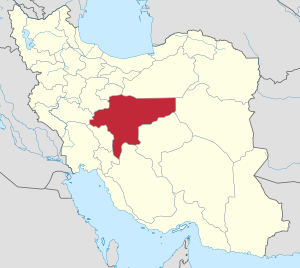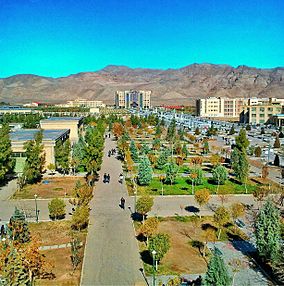Isfahan province facts for kids
Quick facts for kids
Isfahan Province
استان اصفهان
|
|
|---|---|

Location of Isfahan province within Iran
|
|
| Country | Iran |
| Region | Region 2 |
| Capital | Isfahan |
| Counties | 29 |
| Area | |
| • Total | 107,018 km2 (41,320 sq mi) |
| Population | |
| • Total | 5,120,850 |
| • Estimate
(2020)
|
5,343,000 |
| • Density | 47.85036/km2 (123.9319/sq mi) |
| Time zone | UTC+03:30 (IRST) |
| Main language(s) | Predominantly Persian. small Minority: Bakhtiari Luri, Qashqai, Georgian, Armenian languages in some regions of the province |
| HDI (2017) | 0.830 very high · 3rd |
| Isfahan Province Historical population | ||
|---|---|---|
| Year | Pop. | ±% |
| 1966 | 1,703,701 | — |
| 1986 | 3,294,916 | +93.4% |
| 2006 | 4,559,256 | +38.4% |
| 2011 | 4,879,312 | +7.0% |
| 2016 | 5,120,850 | +5.0% |
| amar.org.ir | ||
Isfahan Province (Persian: استان اصفهان, romanized: Ostāne Esfahan) is one of Iran's 31 provinces. It is also known as Esfahan, Espahan, or Isphahan. The main city and capital of the province is Isfahan. This province is located right in the middle of Iran. It is part of Iran's Region 2.
In 2016, about 5.1 million people lived in Isfahan Province. This number has grown over the years. In 2006, there were about 4.5 million people. Most people in the province can read and write.
Contents
Geography and Climate
Isfahan Province covers a large area of about 107,018 square kilometers. It is in the center of Iran. Many other provinces border it. To the north are Markazi, Qom, and Semnan. To the south, it borders Fars and Kohgiluyeh and Boyer-Ahmad Province. The city of Aminabad is the southernmost point. To the east, you'll find Yazd. To the west, it borders Lurestan and Chahar Mahal and Bakhtiyari.
The weather in Isfahan Province is usually mild and dry. Temperatures can range from 40.6°C (105°F) on a hot day to 10.6°C (51°F) on a cold winter day. The average yearly temperature is about 16.7°C (62°F). The province gets about 116.9 mm of rain each year. The city of Isfahan itself has a great climate with four clear seasons.
Mountains and Rivers
The highest point in Isfahan Province is Shahankuh mountain. It stands tall at 4,040 meters (about 13,255 feet). This mountain is located near the city of Fereydunshahr.
Isfahan Province has 52 rivers. Most of them are small and only flow sometimes. The most important river is the Zāyanderud. It is 405 km long and has a large basin area.
Plants and Animals
Isfahan Province is home to some unique plants and animals. The Aphanius isfahanensis is a special type of fish. It lives only in the Zayandehrud river basin. You can find it in only three places in the province.
There are also special plants. Allium chlorotepalum is a plant found only in Isfahan Province. Astragalus vernaculus is another common plant, especially in the western parts of the province.
History of Isfahan
Historians believe that Isfahan was first built as a place for defense and military. Castles and forts were built to protect the people living nearby. This protection helped the settlements grow into larger towns. Some of these old castles include Atashgah, Sarooyieh, Tabarok, Kohan Dej, and Gard Dej. The oldest sites are Ghal'eh Sefeed and Tamijan, which date back to prehistoric times. The historic village of Abyaneh also has ancient ruins and fire temples from the Sassanid period.
In the 1600s and 1700s, Isfahan Province was very rich and successful. This was because the city of Isfahan became the capital of the Safavid Persian Empire. While Isfahan was the main city for the rulers, Kashan was a popular place for them to relax and enjoy their free time.
Administrative Divisions
Isfahan Province is divided into different areas called counties. Each county has its own cities and towns. The largest county by population is Isfahan County.
| Administrative Divisions | 2006 | 2011 | 2016 |
|---|---|---|---|
| Aran va Bidgol County | 89,961 | 97,409 | 103,517 |
| Ardestan County | 43,585 | 41,405 | 42,105 |
| Borkhar County1 | — | 108,933 | 122,419 |
| Borkhar and Meymeh County2 | 277,783 | — | — |
| Buin Miandasht County3 | — | — | 24,163 |
| Chadegan County | 33,684 | 33,942 | 32,479 |
| Dehaqan County | 34,149 | 34,844 | 34,511 |
| Falavarjan County | 232,019 | 247,014 | 249,814 |
| Faridan County | 81,622 | 79,743 | 49,890 |
| Fereydunshahr County | 38,955 | 38,334 | 35,654 |
| Golpayegan County | 82,601 | 87,479 | 90,086 |
| Harand County4 | — | — | — |
| Isfahan County | 1,963,315 | 2,174,172 | 2,243,249 |
| Jarqavieh County4 | — | — | — |
| Kashan County | 297,000 | 323,371 | 364,482 |
| Khansar County | 31,542 | 32,423 | 33,049 |
| Khomeyni Shahr County | 282,888 | 311,629 | 319,727 |
| Khur and Biabanak County5 | — | 17,793 | 19,761 |
| Kuhpayeh County4 | — | — | — |
| Lenjan County | 225,559 | 246,510 | 262,912 |
| Mobarakeh County | 132,925 | 143,474 | 150,441 |
| Nain County | 54,298 | 38,077 | 39,261 |
| Najafabad County | 279,014 | 300,288 | 319,205 |
| Natanz County | 43,947 | 42,239 | 43,977 |
| Semirom County | 70,735 | 65,047 | 74,109 |
| Shahin Shahr and Meymeh County1 | — | 196,584 | 234,667 |
| Shahreza County | 139,702 | 149,555 | 159,797 |
| Tiran and Karvan County | 64,043 | 69,047 | 71,575 |
| Varzaneh County4 | — | — | — |
| Total | 4,499,327 | 4,879,312 | 5,120,850 |
| 1A successor to Borkhar and Meymeh County 2Split into two counties 3Separated from Faridan County 4Separated from Isfahan County 5Separated from Nain County |
|||
Cities of Isfahan Province
Most of the people in Isfahan Province live in cities. In 2016, over 88% of the population lived in cities. The largest city is Isfahan itself, with nearly 2 million people. Other important cities include Kashan, Khomeyni Shahr, and Najafabad. There are many other smaller cities and towns across the province.
People and Languages
Isfahan Province is home to many different groups of people. Most residents speak Persian. However, there are also groups like Bakhtiari Lurs, Kurds, Georgians, Armenians, and Qashqais. Some Persian Jews also live in the province.
While Persian is the official language, many ethnic groups speak their own languages. These include Judeo-Persian, Armenian, Georgian, Qashqai Turkic, Kurdish, and Bakhtiari Lurish. Isfahan Province is famous for producing many talented people. These include poets, scholars, thinkers, religious leaders, and scientists.
Economy and Industry
Isfahan Province is important for Iran's economy. It produces a lot of saffron each year. It is also the biggest producer of milk and dairy products in Iran.
Technology and Military
The province has a modern fiber optic network for internet connections. This helps with high-tech industries.
Isfahan Province is also home to several military sites. There is the Esfahan nuclear fuel research and production center. The Hesa company is also located here. Hesa works on aerospace technology, helicopter maintenance, and weapons.
Tourism and Attractions
Isfahan Province has many beautiful and historic places to visit. The city of Isfahan is especially famous for its stunning bridges.
- Shahrestan bridge
- Khajoo (Khaju) Bridge
- Si-O-Se-Pol bridge
- Choobi Bridge (Joubi Bridge)
Local Cuisine
Isfahan Province has many delicious local dishes. Some well-known foods include:
- Shefte
- Kachi
- Kebab Golpayegan
- Samanu Shahreza
- Carrot stew (Khansar)
- Yokhe bread (Kaak)
- Semirom dishes
Education in Isfahan
Isfahan Province has many universities and colleges. These institutions offer a wide range of studies.
Public Universities
- Isfahan University of Technology
- Isfahan University
- Isfahan University of Medical Sciences
- Kashan University of Medical Sciences
- Isfahan University of Art
- Malek-Ashtar University of Technology
- University of Kashan
Islamic Azad Universities
Several large Islamic Azad University campuses are in the province. These include:
- Islamic Azad University of Falavarjan
- Islamic Azad University of Meymeh
- Islamic Azad University of Kashan
- Islamic Azad University of Majlesi
- Islamic Azad University of Shahreza
- Islamic Azad University of Najafabad
- Islamic Azad University of Khomeynishahr
- Islamic Azad University of Isfahan
- Islamic Azad University of Khorasgan

Images for kids
-
Kashan is another cultural jewel of the province. Seen here is the Agha Bozorg Mosque.
See also
 In Spanish: Provincia de Isfahán para niños
In Spanish: Provincia de Isfahán para niños
- Georgians in Iran
- History of Iran
- List of the historical structures in the Isfahan province
- List of cities in Isfahan Province by population
- Ostandari Isfahan









